Neutron Yield Predictions with Artificial Neural Networks: A Predictive Modeling Approach
Abstract
1. Introduction
1.1. Physical Constraints
1.2. Outline
2. Methods
2.1. Monte Carlo Simulations
2.2. Data Preparation
- We first resampled the data: The simulation output data were sampled logarithmically and are, therefore, relatively sparse in the higher energy end of the spectrum. With sparse data in the energy component and a decline in the particle count by several orders of magnitude, the stability of the surrogate in this area is in question. We circumvented this by linearly resampling the full spectrum. To acquire this resampling, we applied a cubic spline interpolation of the Monte Carlo output data. Both sets, the raw data and the resampled data, are merged, effectively doubling the number of data points. This resampling increases stability in the higher energy range while it keeps the spectral shape unchanged.
- We then rescaled the data using the relations given in Equation (1)where is the renormalized and Y is the raw data generated by the simulation.These two steps are necessary due to the numerical stability of the training process: not only the spareseness of data is problematic in surrogate training. Points with a (orders of magnitude) lower numerical value do contribute much less to the training process metrics than others. As a result, the training process is volatile, which we mitigated by these rescalings.As mentioned previously, the ion input energies are below the spallation threshold, and the unit of the spectral data Y is normalized to the reaction’s source particle. This implies that each data point is between 0 and smaller than 1. After both rescaling steps, the converted output data of the simulation is normalized and ranges between 1 and the normalized maximal value.
- The spectrum also consists of energy information to the count rate. We normalized the resulting neutron’s energy by the neutron cut-off energy to get a scale from 0 to 1.This results in the energy information range from 0 to 1 and allow us to use all spectra in the same training procedure. These maximum energy values are used later in a second model to predict the cut-off energy.
2.3. ANN Setup
2.4. ANN Bootstrap
2.5. Ensuring Generality
3. Results
3.1. Validation against the Raw Simulation Data
- The model predictions beyond the parameter range (see Table 1) are not physical.
- The model can predict the lowest energy neutrons, which cannot be seen in the Monte Carlo spectra. These values, however, have to be used with care: their uncertainty is very high, up to 100%, and the result does not reproduce measurement data correctly (see Section 3.2). The main reason for zero compatible count rates is the bulky target; the lowest neutrons created by low-energy projectiles cannot leave the target and are stuck there or scattered, so they are not counted in the detector. Therefore, the count rates in the simulation are low, meaning the statistical uncertainties are high.
- The characteristic high-energy peak in the forward direction, which occurs in the p-Li reaction due to the transition from Li-7 to the ground/excited state of Be-7, is suppressed (see Figure 4a). The model is based on regression. Due to this, it further suppresses fast signal peaks. It is, therefore, not capable of resolving these peaks.
- The cut-off energies mean squared error is approximately 9 2. This implies an uncertainty of the cut-off energy of approximately .
3.2. Validation against Experimental Data
3.3. Spectra for Different Conventional Setups
3.4. Spectra for Laser-Accelerated Protons
4. Conclusions
Author Contributions
Funding
Data Availability Statement
Acknowledgments
Conflicts of Interest
Appendix A. Detector Details
| Area | Ratio | |||||
|---|---|---|---|---|---|---|
| ° | ° | ° | ° | cm2 | % | |
| D01 | −5 | 5 | 0.0 | 5.0 | 14.94 | 0.19 |
| D02 | 5 | 10 | 7.5 | 2.5 | 44.72 | 0.57 |
| D03 | 10 | 15 | 12.5 | 2.5 | 74.15 | 0.94 |
| D04 | 15 | 25 | 20.0 | 5.0 | 234.12 | 2.98 |
| D05 | 25 | 35 | 30.0 | 5.0 | 342.26 | 4.36 |
| D06 | 35 | 45 | 40.0 | 5.0 | 440.00 | 5.60 |
| D07 | 45 | 55 | 50.0 | 5.0 | 524.37 | 6.68 |
| D08 | 55 | 65 | 60.0 | 5.0 | 592.81 | 7.55 |
| D09 | 65 | 75 | 70.0 | 5.0 | 643.24 | 8.19 |
| D10 | 75 | 85 | 80.0 | 5.0 | 674.12 | 8.58 |
| D11 | 85 | 95 | 90.0 | 5.0 | 684.52 | 8.72 |
| D12 | 95 | 105 | 100.0 | 5.0 | 674.12 | 8.58 |
| D13 | 105 | 115 | 110.0 | 5.0 | 643.24 | 8.19 |
| D14 | 115 | 125 | 120.0 | 5.0 | 592.81 | 7.55 |
| D15 | 125 | 135 | 130.0 | 5.0 | 524.37 | 6.68 |
| D16 | 135 | 145 | 140.0 | 5.0 | 440.00 | 5.60 |
| D17 | 145 | 155 | 150.0 | 5.0 | 342.26 | 4.36 |
| D18 | 155 | 165 | 160.0 | 5.0 | 234.12 | 2.98 |
| D19 | 165 | 170 | 167.5 | 2.5 | 74.15 | 0.94 |
| D20 | 170 | 175 | 172.5 | 2.5 | 44.72 | 0.57 |
| D21 | 175 | 185 | 180.0 | 5.0 | 14.94 | 0.19 |
Appendix B. Parameters and Traits for the Artificial Neural Network Model
Appendix B.1. Hyperparameters
Appendix B.2. Input Vectors
| Position | Quantity | OHE/Max | Description |
|---|---|---|---|
| 0 | /150 MeV | Energy value for which the neutron yield should be predicted. | |
| 1 | /100 MeV | Energy of the projectile causing the reaction. | |
| 2 | Length | /10.5 cm | Length of the converter. |
| 3 | Theta | /180 degree | Scattering angle for which the prediction should be done. |
| 4 | Project | OHE P | The type of the projectile is encoded with one-hot encoding. |
| 5 | Conv[0] | OHE T1 | First bit of the one-hot encoded converter material. |
| 6 | Conv[1] | OHE T2 | Second bit of the one-hot encoded converter material. |
| 7 | Conv[2] | OHE T3 | Third bit of the one-hot encoded converter material |
| Position | Quantity | OHE/Max | Description |
|---|---|---|---|
| 0 | /100 MeV | Energy of the projectile causing the reaction. | |
| 1 | Length | /10.5 cm | Length of the converter. |
| 2 | Theta | /180 degree | Scattering angle for which the prediction should be done. |
| 3 | Project | OHE P | The type of the projectile is encoded with one-hot encoding. |
| 4 | Conv[0] | OHE T1 | First bit of the one-hot encoded converter material. |
| 5 | Conv[1] | OHE T2 | Second bit of the one-hot encoded converter material. |
| 6 | Conv[2] | OHE T3 | Third bit of the one-hot encoded converter material |
References
- Otake, Y. RIKEN Compact Neutron Systems with Fast and Slow Neutrons. Plasma Fusion Res. 2018, 13, 2401017. [Google Scholar] [CrossRef]
- Rücker, U.; Cronert, T.; Voigt, J.; Dabruck, J.P.; Doege, P.E.; Ulrich, J.; Nabbi, R.; Beßler, Y.; Butzek, M.; Büscher, M.; et al. The Jülich high-brilliance neutron source project. Eur. Phys. J. Plus 2016, 131, 19. [Google Scholar] [CrossRef]
- Thulliez, L.; Letourneau, A.; Schwindling, J.; Chauvin, N.; Sellami, N.; Ott, F.; Menelle, A.; Annighöfer, B. First steps toward the development of SONATE, a Compact Accelerator driven Neutron Source. EPJ Web Conf. 2020, 239, 17011. [Google Scholar] [CrossRef]
- ESFRI Physical Sciences and Engineering Strategy Working Group-NeutronLandscape Group. Neutron Scattering Facilities in Europe—Present Status and Future Perspectives; European Strategy Forum on Research Infrastructures: Brussels, Belgium, 2015; Volume 1. [Google Scholar]
- Conrad, H. Handbook of Particle Detection and Imaging; Springer International Publishing: Berlin/Heidelberg, Germany, 2021; Chapter Spallation: Neutrons Beyond Nuclear Fission; pp. 1001–1040. [Google Scholar] [CrossRef]
- Buffler, A. Contraband detection with fast neutrons. Radiat. Phys. Chem. 2004, 71, 853–861. [Google Scholar] [CrossRef]
- Roth, M.; Schollmeier, M. Ion Acceleration—Target Normal Sheath Acceleration. In CERN Yellow Reports, Volume 1 (2016): Proceedings of the 2014 CAS–CERN Accelerator School: Plasma Wake Acceleration, Geneva, Switzerland, 23–29 November 2014; CAS: Geneva, Switzerland, 2016. [Google Scholar] [CrossRef]
- International Atomic Energy Agency. Compact Accelerator Based Neutron Sources; Number 1981 in TECDOC Series; International Atomic Energy Agency: Vienna, Austria, 2021. [Google Scholar]
- Schmitz, B. Towards Compact Laser-Driven Neutron Sources: A Numerical Study of Liquid Leaf Targets for High Repetition Rate Laser Experiments and Neutron Production Using Deep Learning. Ph.D. Thesis, Technische Universität Darmstadt, Darmstadt, Germany, 2023. [Google Scholar] [CrossRef]
- Wakabayashi, Y.; Taketani, A.; Hashiguchi, T.; Ikeda, Y.; Kobayashi, T.; Wang, S.; Yan, M.; Harada, M.; Ikeda, Y.; Otake, Y. A function to provide neutron spectrum produced from the 9Be + p reaction with protons of energy below 12 MeV. J. Nucl. Sci. Technol. 2018, 55, 859–867. [Google Scholar] [CrossRef]
- Sato, T.; Iwamoto, Y.; Hashimoto, S.; Ogawa, T.; Furuta, T.; Abe, S.I.; Kai, T.; Tsai, P.E.; Matsuda, N.; Iwase, H.; et al. Features of Particle and Heavy Ion Transport code System (PHITS) version 3.02. J. Nucl. Sci. Technol. 2018, 55, 684–690. [Google Scholar] [CrossRef]
- Forrest, R.; Capote, R.; Otsuka, N.; Kawano, T.; Koning, A.; Kunieda, S.; Sublet, J.C.; Watanabe, Y. FENDL-3 Library Summary Documentation; Technical Report; International Atomic Energy Agency: Vienna, Austria, 2012. [Google Scholar]
- Diaconis, P.; Efron, B. Computer-Intensive Methods in Statistics. Sci. Am. 1983, 248, 116–130. [Google Scholar] [CrossRef]
- Efron, B.; Stein, C. The Jackknife Estimate of Variance. Ann. Stat. 1981, 9, 586–596. [Google Scholar] [CrossRef]
- Otuka, N.; Dupont, E.; Semkova, V.; Pritychenko, B.; Blokhin, A.; Aikawa, M.; Babykina, S.; Bossant, M.; Chen, G.; Dunaeva, S.; et al. Towards a More Complete and Accurate Experimental Nuclear Reaction Data Library (EXFOR): International Collaboration Between Nuclear Reaction Data Centres (NRDC). Nucl. Data Sheets 2014, 120, 272–276. [Google Scholar] [CrossRef]
- Zerkin, V.; Pritychenko, B. The experimental nuclear reaction data (EXFOR): Extended computer database and Web retrieval system. Nucl. Instruments Methods Phys. Res. Sect. A Accel. Spectrometers Detect. Assoc. Equip. 2018, 888, 31–43. [Google Scholar] [CrossRef]
- Howard, W.B.; Grimes, S.M.; Massey, T.N.; Al-Quraishi, S.I.; Jacobs, D.K.; Brient, C.E.; Yanch, J.C. Measurement of the Thick-Target 9Be(p,n) Neutron Energy Spectra. Nucl. Sci. Eng. 2001, 138, 145. [Google Scholar] [CrossRef]
- Kamada, S.; Itoga, T.; Unno, Y.; Takahashi, W.; Oishi, T.; Baba, M. Measurement of energy-angular neutron distribution for 7Li, 9Be(p,xn) reaction at EP = 70 MeV and 11 MeV. J. Korean Phys. Soc. 2011, 59, 1676. [Google Scholar] [CrossRef]
- Osipenko, M.; Ripani, M.; Alba, R.; Ricco, G.; Schillaci, M.; Barbagallo, M.; Boccaccio, P.; Celentano, A.; Colonna, N.; Cosentino, L.; et al. Measurement of neutron yield by 62 MeV proton beam on a thick beryllium target. Nucl. Instruments Methods Phys. Res. Sect. A Accel. Spectrometers Detect. Assoc. Equip. 2013, 723, 8–18. [Google Scholar] [CrossRef]
- Schmitz, B.; Metternich, M.; Boine-Frankenheim, O. Automated reconstruction of the initial distribution of laser accelerated ion beams from radiochromic film (RCF) stacks. Rev. Sci. Instrum. 2022, 93, 093306. [Google Scholar] [CrossRef] [PubMed]
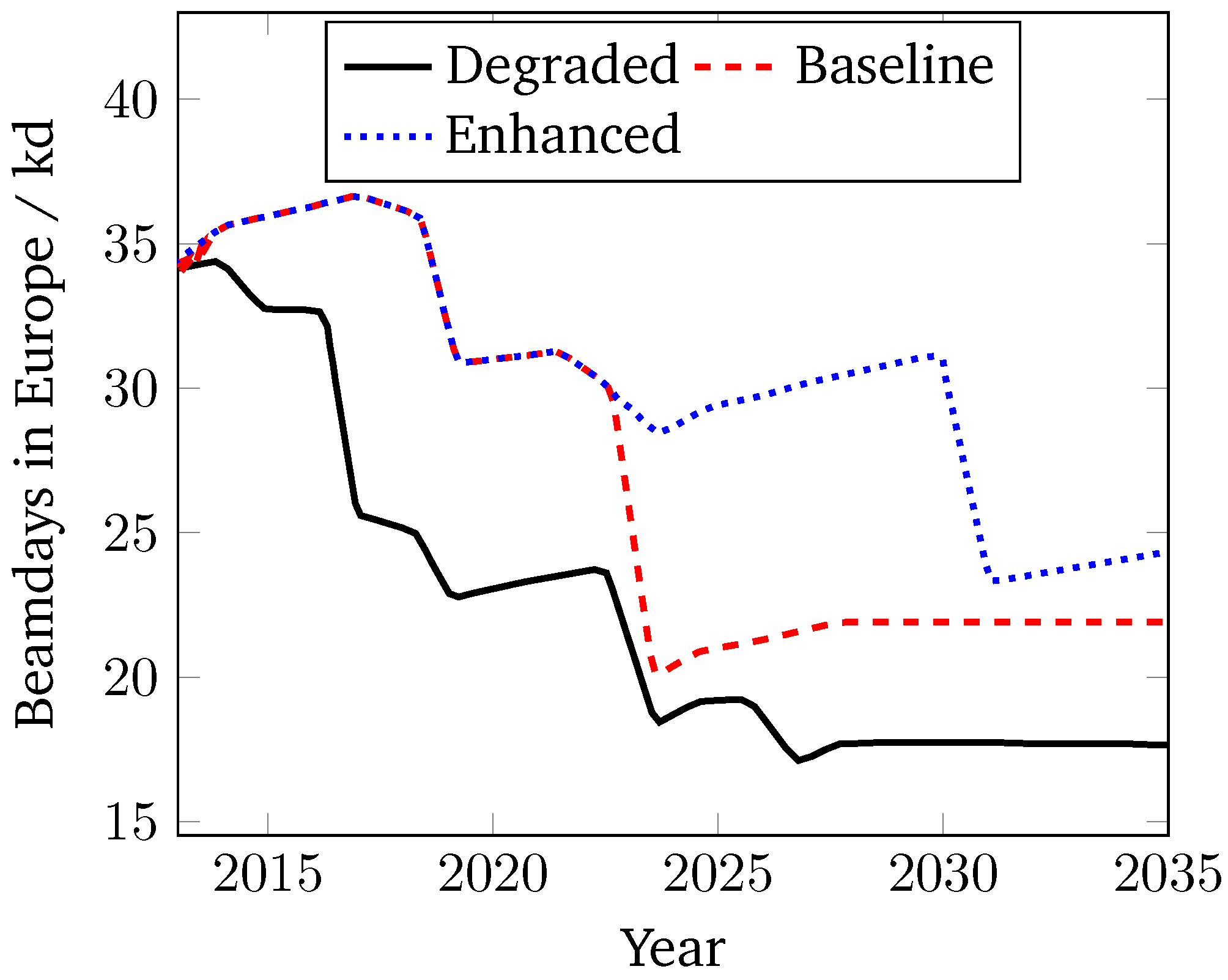

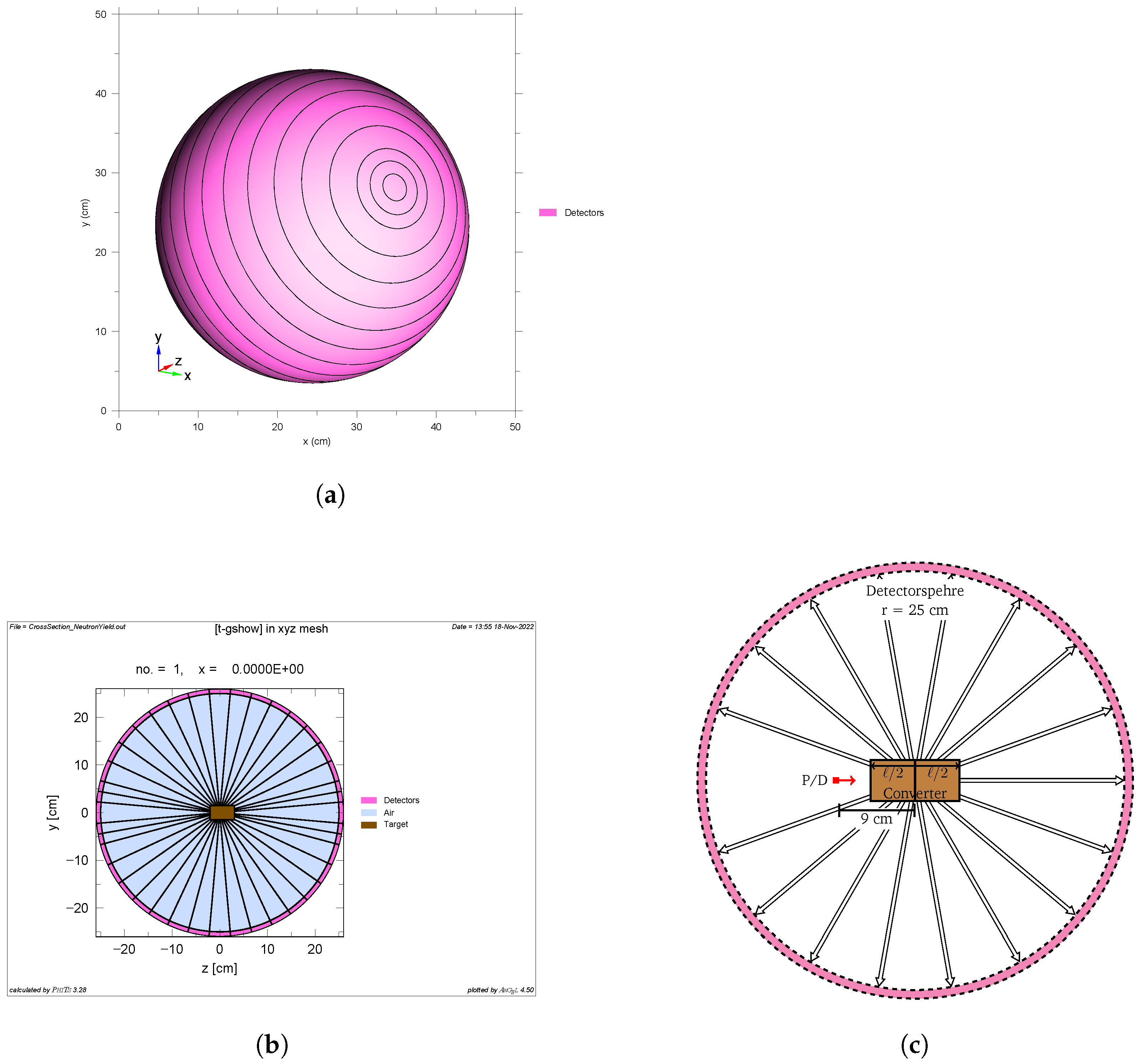
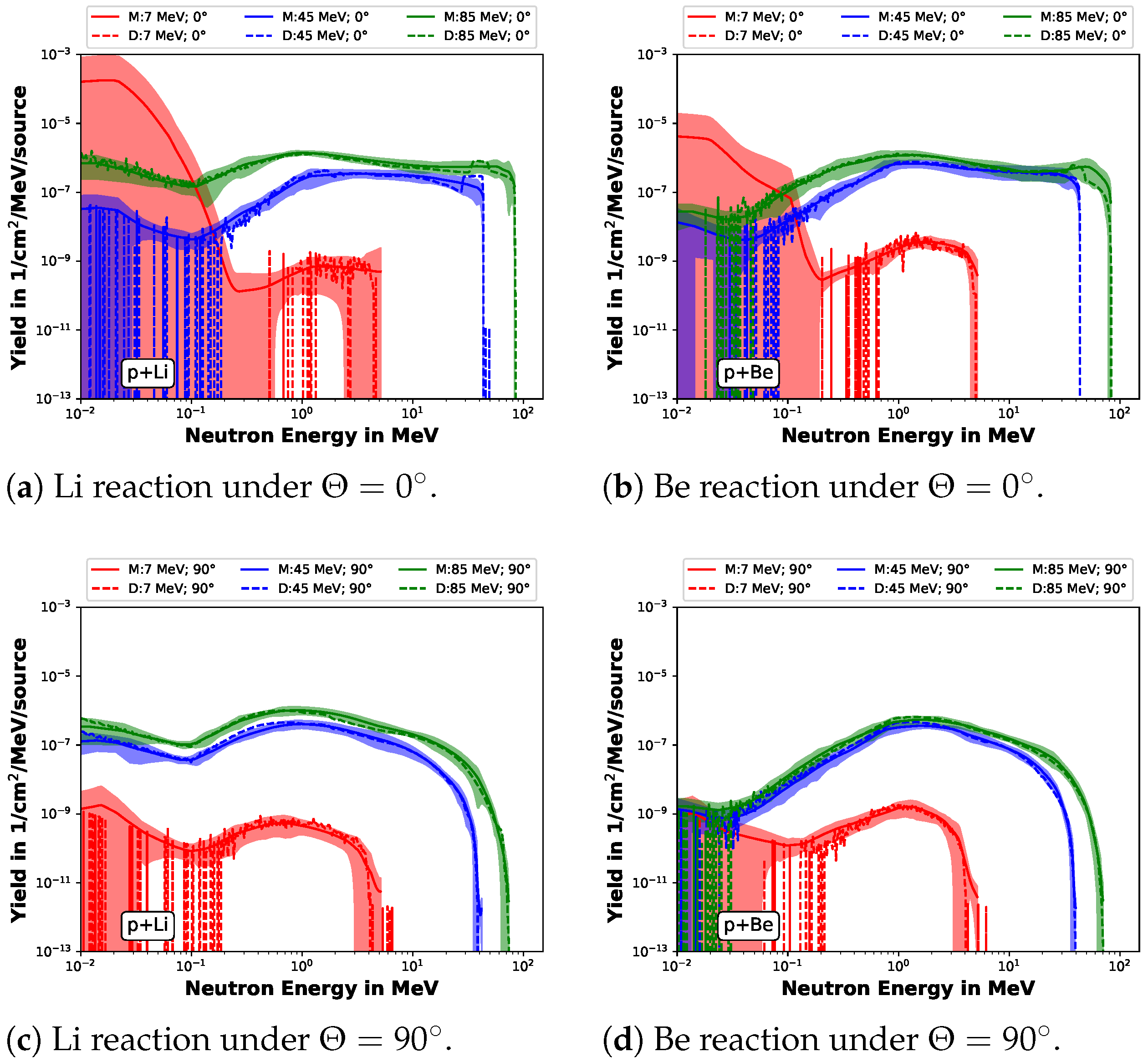
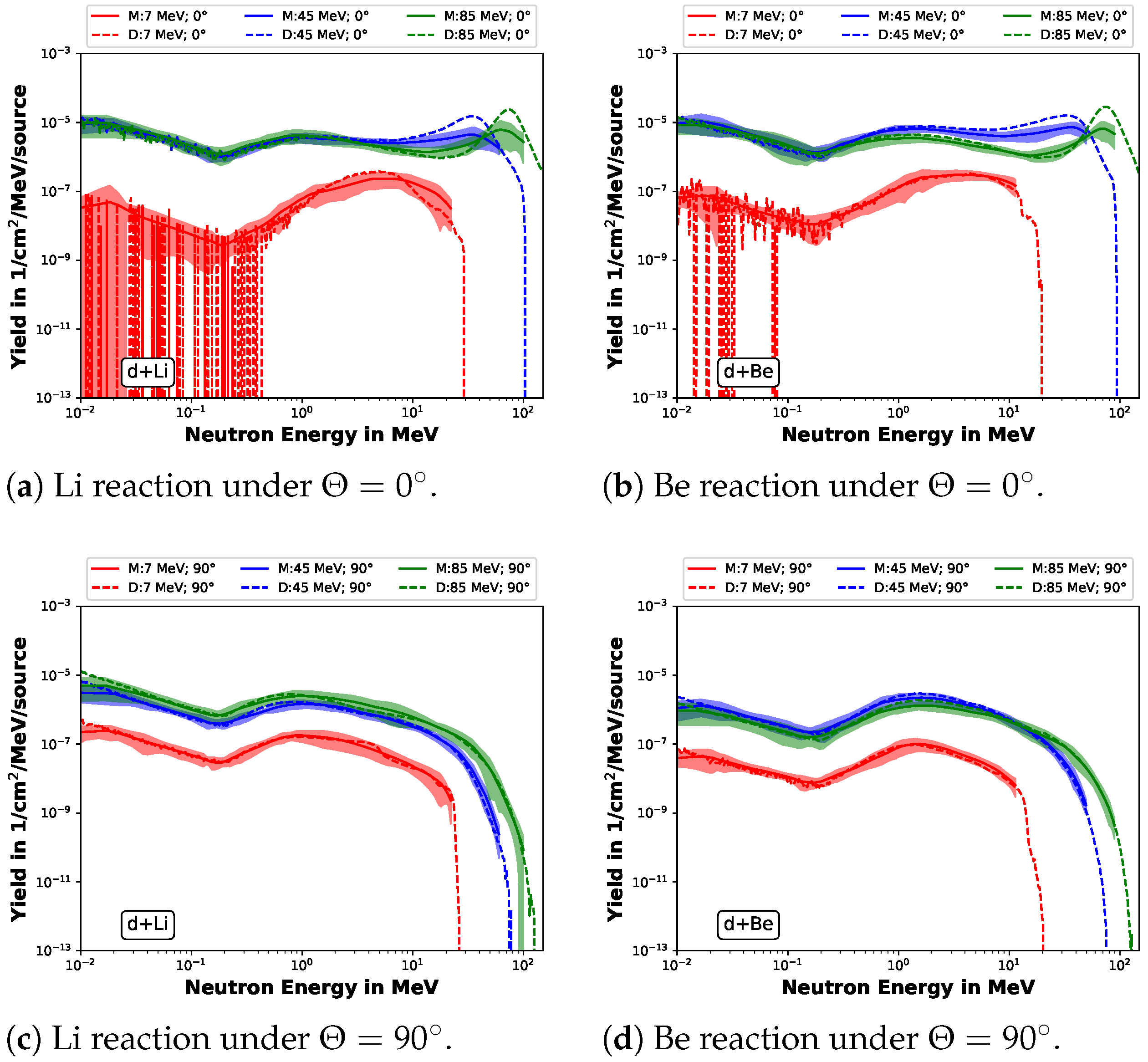

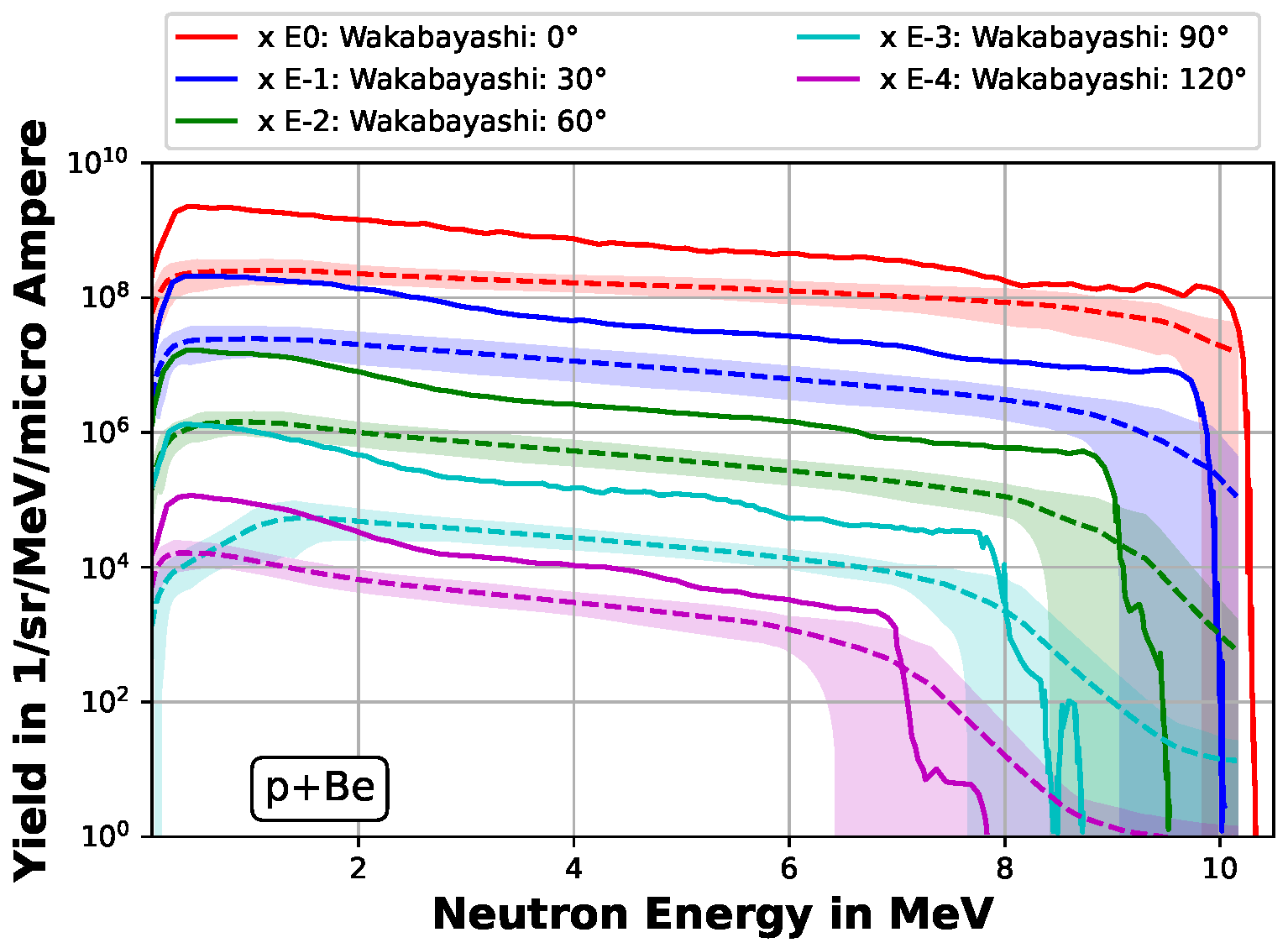
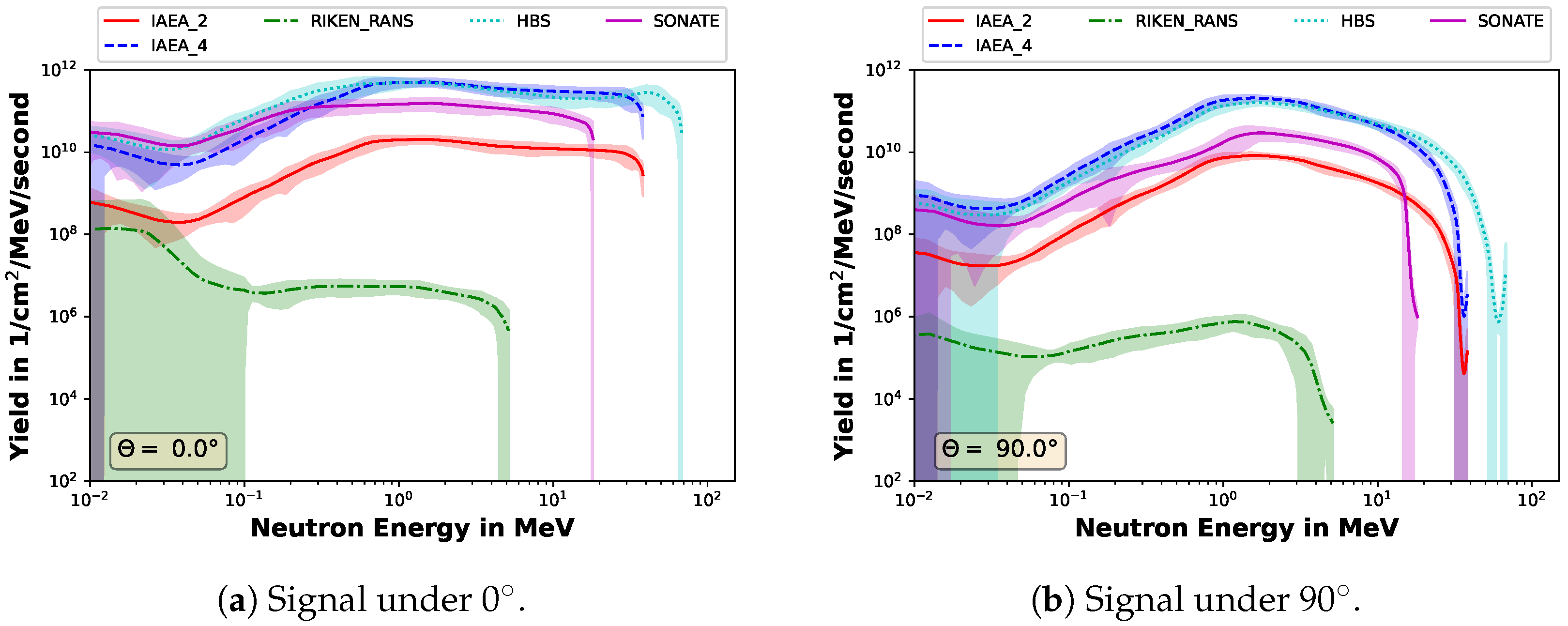
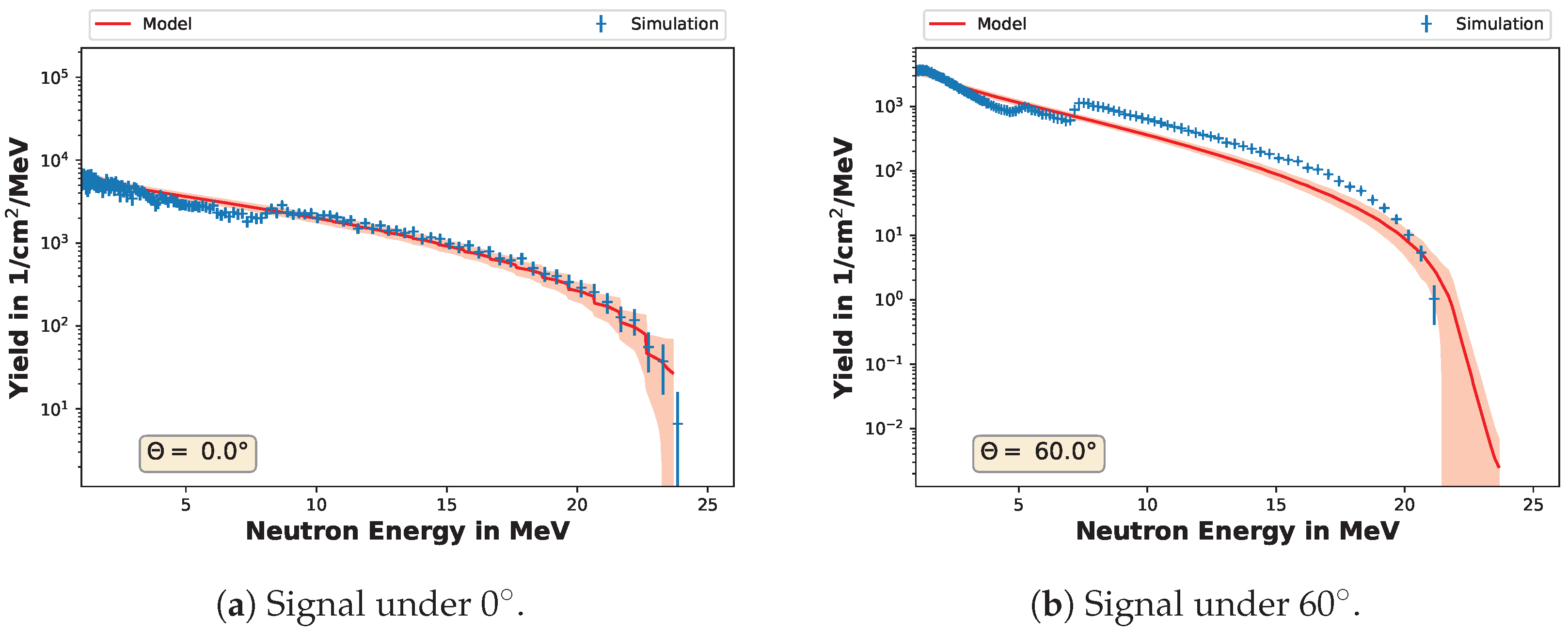
| Quantity | Values | Steps |
|---|---|---|
| Projectile | Deuterons, Protons | 2 |
| Source Radius/cm | 0.5 | fix |
| /MeV | 56 | |
| Element | Li, LiF, Be, Va, Ta | 5 |
| Length/cm | 356 | |
| Angle/° | 21 | |
| Converter Radius/cm | 2.4 | fix |
| Id | MSE | Normalization |
|---|---|---|
| 0 | 0.00128 | −16.0505 |
| 1 | 0.00124 | −16.2796 |
| 2 | 0.00128 | −15.9784 |
| 3 | 0.00119 | −16.6231 |
| 4 | 0.00114 | −16.9578 |
| 5 | 0.00114 | −16.8753 |
| 6 | 0.00125 | −16.1653 |
| 7 | 0.00120 | −16.5274 |
| 8 | 0.00140 | −15.3819 |
| 9 | 0.00121 | −16.4534 |
| Name | Energy | Current | |
|---|---|---|---|
| Unit | MeV | 10−4 A | cm |
| IAEA2 | 40 | 50 | 2.0 |
| IAEA4 | 40 | 1250 | 2.0 |
| RANS | 7 | 1 | 0.03 |
| HBS | 70 | 1000 | 1.6 |
| SONATE | 20 | 1000 | 0.2 |
Disclaimer/Publisher’s Note: The statements, opinions and data contained in all publications are solely those of the individual author(s) and contributor(s) and not of MDPI and/or the editor(s). MDPI and/or the editor(s) disclaim responsibility for any injury to people or property resulting from any ideas, methods, instructions or products referred to in the content. |
© 2024 by the authors. Licensee MDPI, Basel, Switzerland. This article is an open access article distributed under the terms and conditions of the Creative Commons Attribution (CC BY) license (https://creativecommons.org/licenses/by/4.0/).
Share and Cite
Schmitz, B.; Scheuren, S. Neutron Yield Predictions with Artificial Neural Networks: A Predictive Modeling Approach. J. Nucl. Eng. 2024, 5, 114-127. https://doi.org/10.3390/jne5020009
Schmitz B, Scheuren S. Neutron Yield Predictions with Artificial Neural Networks: A Predictive Modeling Approach. Journal of Nuclear Engineering. 2024; 5(2):114-127. https://doi.org/10.3390/jne5020009
Chicago/Turabian StyleSchmitz, Benedikt, and Stefan Scheuren. 2024. "Neutron Yield Predictions with Artificial Neural Networks: A Predictive Modeling Approach" Journal of Nuclear Engineering 5, no. 2: 114-127. https://doi.org/10.3390/jne5020009
APA StyleSchmitz, B., & Scheuren, S. (2024). Neutron Yield Predictions with Artificial Neural Networks: A Predictive Modeling Approach. Journal of Nuclear Engineering, 5(2), 114-127. https://doi.org/10.3390/jne5020009






